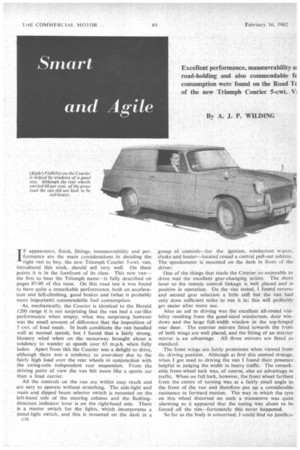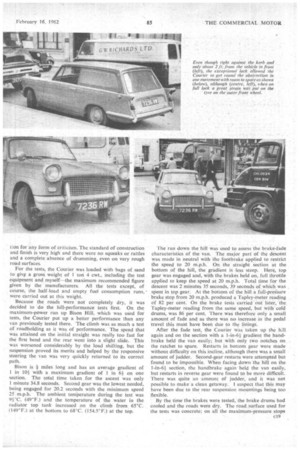Smart and Agile
Page 48

Page 49

Page 50

If you've noticed an error in this article please click here to report it so we can fix it.
By A. J. P. WILDING
IF appearance, finish, fittings, manoeuvrability and performance are the main considerations in deciding the right van to buy, the new Triumph Courier 5-cwt. van, introduced this week, should sell very well. On these points it is in the forefront of its class. This new van— the first to bear the Triumph name—is fully described on pages 87-90 of this issue. On this road test it was found to have quite a remarkable performance, both on acceleration and hill-climbing, good brakes and (what is probably more important) commendable fuel consumption.
As, mechanically, the Courier is identical to the Herald 1200 range it is not surprising that the van had a car-like performance when empty; what was surprising however was the small amount of difference that the imposition of 5 cwt. of load made. In both conditions the van handled well at normal speeds, but I found that a fairly strong, blustery wind when on the motorway brought about a tendency to wander at speeds over 65 m.p.h. when fully laden, Apart from this the Courier was a delight to drive, although there was a tendency to over-steer due to the fairly high load over the rear wheels in conjunction with the swing-axle independent rear suspension. From the driving point of view the van fell more like a sports ear than a load carrier.
All the controls on the van are within easy reach and are easy to operate without stretching. The side-light and main and dipped beam selector switch is mounted on the left-hand side of the steering column and the flashing. direction indicator lever is on the right-hand side. There is a master switch for the lights, which incorporates a panel-light switch, and this is mounted on the dash in a
c18 group of controls—for the ignition, windscreen wipers, choke and heater—located round a central pull-out ashtray. The speedometer is mounted on the dash in front of the driver.
One of the things that made the Courier so enjoyable to drive was the excellent gear-changing action. The short lever to the remote control linkage is well placed and is positive in operation. On the van tested, I found reverse and second gear selection a little stiff but the van had only done sufficient miles to run it in; this will probably get easier after more use.
Also an aid to driving was the excellent all-round visibility resulting from the good-sized windscreen, door windows and the large full-width window in the top-hinged rear door. The exterior mirrors fitted towards the front of both wings are well placed, and the fitting of an interior mirror is an advantage. All three mirrors are fitted as standard.
The front wings are fairly prominent when viewed from the driving position. Although at first this seemed strange. when I got used to driving the van I found their presence helpful in judging the width in heavy traffic. The remarkable front-wheel lock was, of course, also an advantage in traffic. When on full lock, however, the front wheel farthest . fi orn the centre of turning was at a fairly small angle to the front of the van and therefore put up a considerable resistance to forward motion. The way in which the tyre on this wheel distorted on such a manceuvre was quite alarming as it appeared that the casing was about to be forced off the rim—fortunately this never happened.
So far as the body is concerned, I could find no justifica Lion for any form of criticism. The standard of construction and finish is very high and there were no squeaks or rattles and a complete absence of drumming, even on very rough road surfaces.
For the tests, the Courier was loaded with bags of sand to give a gross weight of 1 ton 4 cwt., including the test equipment and myself—the maximum recommended figure given by the manufacturers. All the tests except, of course, the half-load and empty fuel consumption runs, were carried out at this weight.
Because the roads were not completely dry, it was decided to do the hill-performance tests first. On the maximum-power run up Bison Hill, which was used for tests, the Courier put up a better performance than any van previously tested there. The climb was as much a test of roadholding as it was of performance. The speed that was attained on the initial straight was really too fast for the first bend and the rear went into a slight slide. This was worsened considerably by the load shifting, but the suspension proved its merits and helped by the responsive steering the van was very quickly returned to its correct path.
Bison is miles long and has an average gradient of 1 in 10+ with a maximum gradient of 1 in 6+ on one section. The total time taken for the ascent was only 1 minute 34.8 seconds. Second gear was the lowest needed, being engaged for 20.2 seconds with the minimum speed 25 m.p.h. The ambient temperature during the test was 91°C. (49°F.) and the temperature of the water in the radiator top tank increased on the climb from 65°C. (149°F.) at the bottom to 68*C. (154.5°F.) at the top.
The run down the hill was used to assess the brake-fade characteristics of the van. The major part of the descent was made in neutral with the footbrake applied to restrict the speed to 20 m.p.h. On the straight section at the bottom of the hill, • the gradient is • less steep. Here, top gear was engaged and, with the brakes held on, full throttle applied to keep the speed at 20 m.p.h. Total time for the descent was 2 minutes 35 seconds, 39 seconds of which was spent in top gear. At the bottom of the hill a full-pregSure brake stop from 20 m.p.h. produced a Tapley-meter reading of 82 per cent. On the brake tests carried out later, the Tapley-meter reading from the same speed, but with cold drums, was 86 per cent. There was therefore only a small amount of fade and as there was no increase in the pedal travel this must have been due to the linings.
After the fade test, the Courier was taken up the hill again and on the section with a 1-in-61 gradient the handbrake held the van easily; but with only two notches on the ratchet to spare. Restarts in bottom gear were made without difficulty on this incline, although there was a small amount of judder. Second-gear restarts were attempted but found to be impossible. When facing down the hill on the 1-in-6+ section, the handbrake again held the van easily, but restarts in reverse gear were found to be more difficult. There was quite an amount of judder, and it was not possible to make a clean getaway. I suspect that this may have been due to the rear suspension. mountings being too flexible.
By the time the brakes were tested, the brake drums had cooled and the roads were dry. The road ,surface used for the tests was concrete; on all the maximum-pressure stops c19 the Courier was completely stable. Braking balance was very good; on every stop all wheels marked the road evenly.
The figures obtained on the maximum-acceleration tests through the gears were exceptionally good for a van. Those for direct-drive were reasonable in view of the relatively high final-drive ratio in'spite of which there was a surprisingly good pick up from 10 m.p.h.
Fuel-consumption tests were carried out on the six-mile out-and-return run on the A6 north of Barton. Premium grade fuel was used throughout the tests and the figures obtained were well up to the current standard for 5-cwt. vans. No high-speed motorway fuel-consumption run was made because of a strong blustery wind, but the motorway was used to check the maximum speeds in the gears. Taking into account a speedometer inaccuracy of one per cent. at 30 m.p.h. and four per cent. at 60 m.p.h., these were 25, 43 and 62 m.p.h.-first, second and third respectively. Because the conditions made the steering difficult to control at speeds of over 65 m.p.h., the maximum speed in top gear was not checked. A speed of 74 m.p.h. is claimed.
Reduced greasing is a feature of the chassis design, and routine or driver maintenance is helped greatly by the forward-hinged bonnet and front wing assembly, which gives outstanding accessibility to the engine and other com c20 ponents. A number of jobs were carried out to get an idea of the time routine checks would take. Once the bonnet and wing unit was opened (this took 12 seconds and II seconds to close again), the engine oil level was checked in 11 seconds, the level of the battery electrolyte 43 seconds and the fluid levels in both brake and clutch reservoirs took 14 seconds to check. The time taken to check the contact breaker points gap was 52 seconds and No. 2 sparking plug was changed in 1 minute 54 seconds. The paper element in the engine air cleaner should be cleaned every 3,000 miles. This job took 3 minutes 5 seconds.
Because the ground clearance is fairly small, I found it necessary to jack up one side of the van to enable me to get underneath to check the gearbox and rear drive unit oil levels. The total time taken to do this and check both levels was 6 minutes 17 seconds. The final tasks undertaken were all-round brake adjustment and a wheel change. For both, the jack supplied was used and the brakes on all wheels were adjusted in 10 minutes 39 seconds (no suitable spanner or key was included in the tool kit for this job) whilst just 6 minutes was spent changing a rear wheel. These times include getting out the jack from under the rear floor section, jacking up and lowering the vehicle and replacing the jack.












































































































